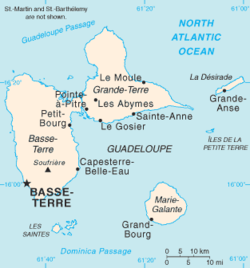Invasion of Guadeloupe (1810)
| Invasion of Guadeloupe | |||||||
|---|---|---|---|---|---|---|---|
| Part of the Napoleonic Wars | |||||||
 Guadeloupe. The invasion forces landed on the southern and western coasts. |
|||||||
|
|||||||
| Belligerents | |||||||
|
|
|
||||||
| Commanders and leaders | |||||||
|
Sir Alexander Cochrane George Beckwith |
Jean Augustin Ernouf | ||||||
| Strength | |||||||
| 6,700 British Army soldiers, Royal Navy ships in support | 3,000–4,000 French Army soldiers and militia | ||||||
| Casualties and losses | |||||||
| 52 killed, 250 wounded, seven missing | 500–600 casualties. The island, entire garrison and large quantities of military equipment captured. | ||||||
The Invasion of Guadeloupe was a British amphibious operation fought between 28 January and 6 February 1810 over control of the Caribbean island of Guadeloupe during the Napoleonic Wars. The island was the final remaining French colony in the Americas, following the systematic invasion and capture of the others during 1809 by British forces. During the Napoleonic Wars, the French colonies had provided protected harbours for French privateers and warships, which could prey on the numerous British trade routes in the Caribbean and then return to the colonies before British warships could react. In response, the British instituted a blockade of the islands, stationing ships off every port and seizing any vessel that tried to enter or leave. With trade and communication made dangerous by the British blockade squadrons, the economies and morale of the French colonies began to collapse, and in the summer of 1808 desperate messages were sent to France requesting aid.
Despite repeated efforts, the French Navy failed to reinforce and resupply the garrison, as their ships were intercepted and defeated either in European waters or in the Caribbean itself. The British had intercepted a number of these messages, and launched a series of successful invasions during 1809, until Guadeloupe was the only French colony remaining. A British expeditionary force landed on 28 January 1810, and found that much of the island's militia garrison had deserted. Advancing from two landing beaches on opposite sides of the island, they were able to rapidly push inland. It was not until they reached Beaupère–St. Louis Ridge outside the capital Basse-Terre that the expeditionary force faced strong opposition, but in a battle lasting for most of 3 February, the French were defeated and driven back. The island's commander, Jean Augustin Ernouf, began surrender negotiations the following day.
The French West Indian colonies during the Napoleonic Wars were almost completely cut off from France due to the British naval strategy of close blockade: squadrons of British Royal Navy warships patrolled the coasts of both France itself and the West Indian islands under French control. This hindered communications, severely restricted trade and prevented the reinforcement of the French garrisons during the conflict. As a result, the colonies began to suffer food shortages, their economies stagnated and public and military morale began to severely erode. In desperation, the commanders of the main colonies, the Leeward Islands of Martinique and Guadeloupe, sent a series of messages to France during the summer of 1808, entreating the French government to send food and military supplies. The French responded with a series of frigates and smaller vessels, sailing to the Caribbean independently or in small squadrons. Some of these ships reached their destinations, but the majority were captured by the Royal Navy blockades off France or the islands. Those few ships that did safely make port were trapped there, unable to make the return journey without risking defeat by the British ships waiting offshore.
...
Wikipedia
